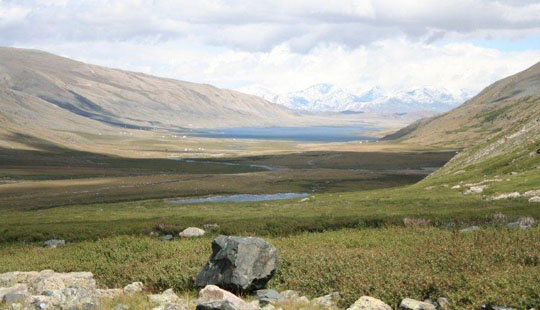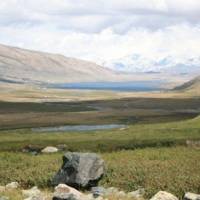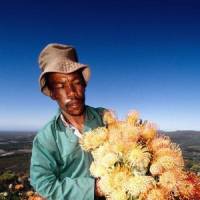Eight years ago in Johannesburg, government delegates from around the world gathered for the World Summit on Sustainable Development — and made a promise "to substantially reduce the rate of loss of biodiversity."
That has not happened.
"Despite the significant progress achieved, we have failed to fulfill the promise . . . we continue to lose biodiversity at an unprecedented rate," admitted Ahmed Djoghlaf, executive secretary of the Convention on Biological Diversity, in London last January.
And this trend continues to worsen.
According to the eighth edition of WWF's Living Planet Report just released, there has been "a fall of 30 percent in the health of species that are the foundation of the ecosystem services on which we all depend," writes James P. Leape, director general of WWF International, in the report.
In addition, humanity's ecological footprint has doubled since 1966, and "in 2007 the footprint exceeded the Earth's biocapacity — the area actually available to produce renewable resources and absorb carbon dioxide — by 50 per cent," states the report.
In short, we now need one-and-a-half planets to provide for all our needs.
The last time humans were still living within the biocapacity of the Earth was 1976. For 35 years now we have been living beyond our means. Incredible.
Rarely do humans exhibit as much irrational exuberance as we do in our willingness to consume resources and degrade the Earth's essential life-support systems that feed, clothe and house us.
Pulitzer Prize-winning author Edward O. Wilson puts it succinctly in his book, "The Future of Life": "Now more than six billion people fill the world. The great majority are very poor; nearly one billion exist on the edge of starvation. All are struggling to raise the quality of their lives any way they can. That unfortunately includes the conversion of the surviving remnants of the natural environment. Half of the great tropical forests have been cleared. The last frontiers of the world are effectively gone. Species of plants and animals are disappearing a hundred or more times faster than before the coming of humanity, and as many as half may be gone by the end of this century. An Armageddon is approaching at the beginning of the third millennium. But it is not the cosmic war and fiery collapse of mankind foretold in sacred scripture. It is the wreckage of the planet by an exuberantly plentiful and ingenious humanity."
With the future of human society in the breach, the 10th Conference of the Parties to the Convention on Biological Diversity is under way in Nagoya, where delegates are faced with the same challenge that has perplexed policymakers for decades: How to rein in human degradation of the planet.
Whether it be sustainability, climate, or biodiversity, we've been here before — but never before with the same urgency.
From the Stockholm Conference in 1972, to Rio in 1992 and Kyoto in 1997, to Johannesburg in 2002 and Copenhagen in 2009, governments, urged on by civil society, have sought to craft a sustainable balance between human consumption and the geophysical limits of Earth's ecosystems.
So far we have proved incapable of striking that balance.
Population is still on the rise along with our pace and volume of consumption. We are quite literally eating ourselves out of house and home, as fish stocks decline, ground waters run dry and forests are cleared for agriculture and urban development.
Now, once again, government delegates have gathered and if sanity and reason prevail they will agree to set aside 15 to 20 percent of both terrestrial and marine areas as sanctuaries. But the amount of the planet they agree to preserve is just the beginning. Delegates will also have to consider how to protect and manage those areas, and, more importantly, how to manage the vast majority of areas that will host agriculture, forestry, mining, urban expansion and other uses.
Our planet's biological diversity, the myriad genes, species and ecosystems that provide the breath, blood, and body of human existence, makes up a vital web within which all life exists.
Knowing this, one would expect governments to be forging ahead with national and international efforts to conserve the planet's remaining biodiversity. Instead, arguments persist over who should lead, who should follow, how much we should protect and, above all, who should pay.
Representatives of 192 countries, under the watchful eyes of numerous international organizations, now have less than one week remaining to agree on a comprehensive strategy to secure and sustainably manage what is left of the planet's biodiversity.
Most difficult will be agreeing on the financing needed to implement such a strategy, including money for research, for the conservation of specific species, and for the protection and management of large areas of terrestrial and marine habitat that host high levels of biodiversity, often in developing nations where demand for basic human needs create incessant pressure to develop.
The challenges are nearly overwhelming, but there are glimmers of hope.
One organization that is playing a key role in efforts to protect and sustainably use our planet's remaining biological resources is the United Nations Development Programme (UNDP). Working with funding from the Global Environment Facility (GEF), the world's largest source of financing for global environment projects, UNDP is implementing a comprehensive approach to biodiversity and ecosystem management.
For nations looking to establish conservation programs that synthesize complementary approaches, the UNDP portfolio offers a useful paradigm.
"Population, consumption and technology are the three most fundamental agents of environmental change. UNDP, as the development arm of the United Nations, is in a unique position to be able to address the critical intersections between the socioeconomic drivers and biodiversity loss in order to ensure the wellbeing of our future generations," explains Nik Sekhran, head of the UNDP's Biodiversity and Ecosystems Programme.
UNDP is concentrating on three foci.
First, it is working to improve the sustainability of protected areas (PAs) that contain the highest concentrations of biodiversity. Between 2005 and 2010, UNDP with GEF finance helped to establish 128 new PAs covering 11.1 million hectares, and 197 more new PAs covering 4.2 million hectares are planned.
Second, because most biodiversity exists outside of PAs in areas that are under pressure from commercial and subsistence activities — including agriculture, forestry, fisheries, human settlements, resource extraction and tourism — UNDP-GEF is working to encourage the adoption and integration of biodiversity-friendly management approaches in these vulnerable areas.
For example, UNDP has established the Green Commodities Facility to make production and supply chains more "biodiversity friendly" in order to reduce pressure on biodiversity in production areas. In Central and South America, a GEF-funded UNDP initiative is helping to increase production of coffee that is grown and certified under biodiversity-friendly systems and according to strict social standards. Purchasers include McDonald's Europe and British Airways, and sales of certified coffee have risen by more than 50,000 metric tons since the project began.
Another useful model of this type of production-preservation balance is Japan's Satoyama Initiative, which weaves together conservation and sustainable use in agricultural areas that border forests.
The third UNDP focus is ecosystem-based adaptation, increasing the resilience of ecosystems so that they can continue to provide ecosystem services essential for human wellbeing, even as climate changes.
One example is UNDP work with Germany's International Climate Initiative. "Different methods will be used depending on local conditions and needs," says Midori Paxton, a regional technical adviser in the UNDP Biodiversity and Ecosystem Programme. "They include adjustment of PA boundaries, creation of ecological corridors to allow better chances of species survival, integrated wildfire management and realization of landscape-level conservation, afforestation using a mixture of tree species, and targeted protection of more vulnerable species and 'climate refugia' — areas which are less likely to be affected by climate change."
The UNDP's Sekhran explained further: "Biodiversity is natural capital with significant economic value. For example, ecosystem services such as pollination underpin the world's agriculture industry, and water provisioning and regulation services of the world forests have enormous value in terms of providing water for households and industries and preventing major floods. Despite this, biodiversity and ecosystem services continue to be degraded because the value of this natural capital is not included in the cost-benefit calculus of national development.
"If we lose biodiversity, we lose options," warns Sekhran. "We close doors of potential that simply cannot be reopened."
Above all, as E.O. Wilson points out in "The Future of Life," humanity needs a new way of thinking about nature. "A global land ethic is urgently needed. Not just any land ethic that might happen to enjoy agreeable sentiment, but one based on the best understanding of ourselves and the world around us that science and technology can provide.
"Surely the rest of life matters. Surely our stewardship is its only hope. We will be wise to listen carefully to the heart, then act with rational intention and the tools we can gather and bring to bear," concludes Wilson.
Stephen Hesse is a professor in the Chuo University Law Faculty and is Director of the Chuo International Center. He can be contacted at: [email protected]






















With your current subscription plan you can comment on stories. However, before writing your first comment, please create a display name in the Profile section of your subscriber account page.